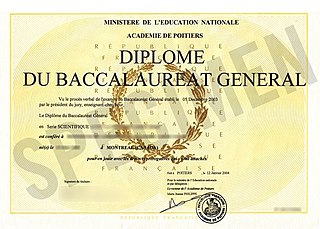Related Research Articles

The General Certificate of Secondary Education (GCSE) is an academic qualification in a range of subjects taken in England, Wales and Northern Ireland, having been introduced in September 1986 and its first exams taken in 1988. State schools in Scotland use the Scottish Qualifications Certificate instead. However, private schools in Scotland often choose to follow the English GCSE system.
Abitur, often shortened colloquially to Abi, is a qualification granted at the end of secondary education in Germany. It is conferred on students who pass their final exams at the end of ISCED 3, usually after twelve or thirteen years of schooling. In German, the term Abitur has roots in the archaic word Abiturium, which in turn was derived from the Latin abiturus.

The baccalauréat, often known in France colloquially as the bac, is a French national academic qualification that students can obtain at the completion of their secondary education by meeting certain requirements. Though it has only existed in its present form as a school-leaving examination since Emperor Napoleon Bonaparte's implementation on March 17, 1808, its origins date back to the first medieval French universities. According to French law, the baccalaureate is the first academic degree, though it grants the completion of secondary education. Historically, the baccalaureate is administratively supervised by full professors at universities.
The eleven-plus (11+) is a standardised examination administered to some students in England and Northern Ireland in their last year of primary education, which governs admission to grammar schools and other secondary schools which use academic selection. The name derives from the age group for secondary entry: 11–12 years.

Twelfth grade is the twelfth year of formal or compulsory education. It is typically the final year of secondary school and K–12 in most parts of the world. Students in twelfth grade are usually 17–18 years old. Some countries have a thirteenth grade, while other countries do not have a 12th grade/year at all.

Education in Poland is compulsory; every child must receive education from when they are 6 years old until they are 18 years old. It is also mandatory for 6-year-old children to receive one year of kindergarten education, before starting primary school at 6 years old. Primary school lasts eight years, and students must take a final exam at the end of the eighth grade. After graduating from primary school, people typically go on to attend secondary school, which lasts 4 or 5 years. They can also choose to educate themselves towards a specific profession or trade, and receive work experience and qualifications through apprenticeships. After graduating from secondary school and passing the final exam, called the matura, one can pursue a higher education at a university, college, etc.
Education in Norway is mandatory for all children aged from 6 to 16. Schools are typically divided into two divisions: primary and lower secondary schooling. The majority of schools in Norway are municipal, where local governments fund and manage administration. Primary and lower secondary schools are available free of charge for all Norwegian citizens as a given right.
In Denmark, the educational system has historically used a number of different systems of grading student performances, several of which are described below. The current grading system is the 7-trins-skala (7-step-scale) which replaced the 13-skala in 2006.
This is an article on the grading that is used in Finland. Several systems are in use in different educational institutions in Finland.
Germany uses a 5- or 6-point grading scale (GPA) to evaluate academic performance for the youngest to the oldest students. Grades vary from 1 to 5. In the final classes of German Gymnasium schools that prepare for university studies, a point system is used with 15 points being the best grade and 0 points the worst. The percentage causing the grade can vary from teacher to teacher.
Academic grading in the Netherlands has remained unchanged for several decades.
Education in Jamaica is primarily modeled on the British education system.
This article introduces the academic grading systems in the Czech Republic.
There are four grading systems in Greece – four different GPA – one for higher education, one for secondary education, and two for primary education.
In Romanian primary schools, a 4-point grading scale is used:
Serbia inherited the academic grading system of the Socialist Federal Republic of Yugoslavia. The grading process uses an absolute achievement scale to determine the grade of a student.
This article is about the grades that are used in Sweden.
In the United States, academic grading commonly takes on the form of five, six or seven letter grades. Traditionally, the grades are A+, A, A−, B+, B, B−, C+, C, C−, D+, D, D− and F, with A+ being the highest and F being lowest. In some cases, grades can also be numerical. Numeric-to-letter-grade conversions generally vary from system to system and between disciplines and status.
This is a list of grading systems used by countries of the world, primarily within the fields of secondary education and university education, organized by continent with links to specifics in numerous entries.
References
- ↑ The example is from the University of Oslo, . Other institutions using similar scales include the Norwegian University of Science and Technology, , Sør-Trøndelag University College, and The Norwegian Police University College, .
- ↑ The grading scale is provided by regulations (forskrift) to the Norwegian education law, see § 4-4
- ↑ 9 av 10 består fag- og svenneprøven Anlegg og Transport 12 February 2019